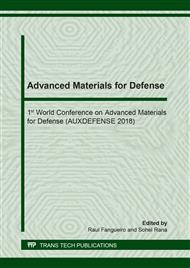p.75
p.84
p.92
p.100
p.107
p.114
p.120
p.127
p.134
Increasing Energy Absorption and Reliability of Beams by Improved Architecture and Web-Flange Junctions
Abstract:
Lightweight and strong composite material beams are increasingly sought to quickly, easily, and cost-effectively transport and setup a variety of constructions such as bridges, cabins/ stores/shelters, vehicles etc. For structural beams produced as conventional laminated composite materials, their weak areas tend to occur at intersections such as web-flange junctions due to absence of fibres bridging the interconnections. This drawback can however be overcome with development of profiled 3D textile reinforcements having combination architectures and constituent web-flange parts inherently mutually interconnected through fibre interlacement. In addition to general strength improvement, beams containing such novel reinforcement architectures also show increased energy absorption capability due to the mutual web-flange integration at the junctions. An ‘I’ and a ‘flanged-triangle’ cross-section beams were produced by a novel non-conventional weaving method, using carbon fibres as reinforcement, and their energy absorption capabilities were tested. These beams respectively absorbed over 50% and 300% more energy per weight in bending, compared to metal counterparts. This paper presents some relevant aspects of these innovative beams.
Info:
Periodical:
Pages:
114-119
Citation:
Online since:
July 2019
Authors:
Price:
Сopyright:
© 2019 Trans Tech Publications Ltd. All Rights Reserved
Share:
Citation:


